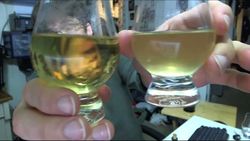Chill Filtering

Why is it used?
Whisky gets its taste and smell from the compounds it contains, most of which are soluble in the water-ethanol mixture characteristic of all alcoholic drinks. This solubility changes with the concentration of alcohol and at certain temperatures.
So when the whisky is diluted with cold water, or simply gets cold enough, molecules clump together to form small particles known as micelles. These scatter light, making the liquid appear cloudy, in a phenomenon known as chill haze. You can only see the compounds, and therefore filter them, when the liquid is cold.
Chill filtering prevents the whisky from becoming hazy when in the bottle, when served, when chilled, or when water or ice is added, as well as precluding sedimentation from occurring in the bottles.
Method
Chill filtering is a method in whisky making for removing micelles. In chill filtering, whisky is cooled to between -10° and 4° Celsius (often roughly 0°) and passed through a fine adsorption filter. This is done mostly for cosmetic reasons – to remove cloudiness, rather than to improve taste or consistency.
Chill filtering works by reducing the temperature sufficiently that some fatty acids, proteins and some esters precipitate out so that they are caught on the filter. Single malt whiskeys are usually chilled down to 0°C, while the temperature for blended whiskey tends to be lower since they have lower levels of fatty acid.
Alternatives to Chill Filtering
Keeping ABV at or above 46% will maintain clarity of product at room temperature. The 46% won't stop your dram from going hazy if you add ice or a touch of water though, as both dilute the product and ice decreases the temperature below normal room temperatures.
Using Wood cellulose to remove haze: Spirit Cloudiness --- A Quick Effective Fix - This is not proven out (Tried & True) yet. It needs to be tried out by members to perfect the process.
Louching
Louching, or the Ouzo effect, is another name for chill haze. In certain spirits where a large amount of essential oils are used louching is expected. It is not considered a fault. It is common in Ouzo, Absinthe, and some gins. For absinthe and other spirits with anethole (Anise and some other botanicals) acts as a emulsifier so that the milkiness doesn't go away.
Serious Eats: Why absinthe louches
Distillique - Louching Effect and Handling It
External Links
- Chill Filtering at Wikipedia
- Sevenfifty.com: The Rise of Unfiltered Spirits
- Blind taste testing of filtered/non filtered Whiskeys
- https://www.bruichladdich.com/article/bruichladdichs-guide-to-chill-filtration
- https://www.theglenlivet.com/chill-filtration-what-it-is-and-why-we-use-it/
- https://www.balblair.com/gathering_place/blog/80_chill_filtering_explained
- https://vinepair.com/wine-blog/what-is-whiskey-chill-filtering/
- Louching/Ozuo Effect at Wikipedia
- Youtube: Ralfy explains Chill haze and Chill Filtration
- Youtube: Cloudy Non Chill Filtered Whisky Example
- Youtube: Ouzo/Louche effect, Anethole and Suspension
- Whiskey Advocate: Chill Filtering